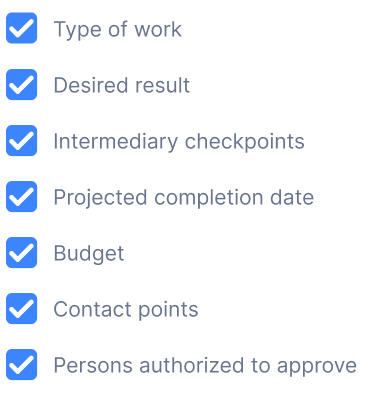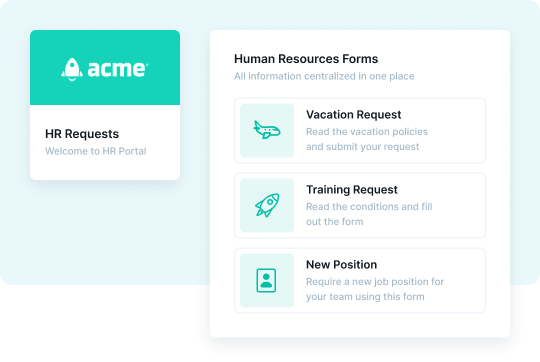
When work comes into your department, what’s the first thing that happens? Do you start working immediately and ask questions later? Or do you take time to evaluate the project and specify what you’ll need to do to complete it?
This is where it’s important to crystallize your intake process. An intake process is just a defined way of stepping back, looking at a request and making a plan to address it.
Citizen Developer’s Guide to Workflow OptimizationDownload now
Definition of intake process
All intake processes tend to follow the same basic trajectory:
- Step 1: Receive information about the type of project including its end goal, budget and deadline.
- Step 2: Create a task sequence that will take the process to completion.
- Step 3: Assign tasks to teams or team members.
- Step 4: Field questions and clarify details.
- Step 5: Confirm launch, messaging all stakeholders.
You can adjust this framework as you need, but you’ll want to keep it as linear as possible. The less you have to circle back, the more time you’ll have for the work itself.
Start by creating an intake form that’s as complete as possible. Make sure it includes information such as:

Your team should develop its intake form and process around the types of information you need to complete work. Review your form several times to make sure it asks for the right information. Then evaluate the rest of the process and see if there’s anything you can automate to save time.
Examples of intake process
When you automate mundane tasks in your intake process, you can begin work sooner. Examine your process for simple or mundane tasks that don’t require in-depth analysis. Examples include:
- Sending confirmation emails
- Assigning and moving a task into someone’s workflow
- Prioritizing tasks based on deadlines
A system like Pipefy can automate steps like these, giving your team more time to analyze the work request and strategize next steps.
Find the right tool to automate your intake process with the Buyer’s Guide to Automation Platforms
Types and steps of Intake Processes
Your intake process structure will vary based on your industry, team structure and company procedures. Here are some examples to get you thinking about possibilities.
Example: IT
IT teams often have multiple types of work to track—service tickets, routine management requests, idea proposals and so on. These teams need intake processes that incorporate the different trajectories of each type of work. For example:

- Step 1: The requester fills out a start form indicating the type of project and specifications. If the requester has more than one option for work category—for instance, an internal department might have a maintenance request or project proposal—they select the correct form within a user portal like Pipefy’s
- Step 2: The system screens the request for missing information or indications that approval is necessary
- Step 3: Someone or the tool itself reviews the completed request and assigns it to a team member, who starts the work by ordering any necessary hardware or parts
If your work types are too diverse to fit into the same intake process, you may need to create separate strategies. Customer intake, for example, often requires a separate framework.
Customer Intake Processes in IT
In IT, customer intake processes focus on future work for a current client. Each process asks and answers questions like:
- Which of our company’s products are you using?
- What is your current infrastructure?
- What integrations do you need?
- What kind of help do you need to get started?
With answers to these questions, your customer success department can assign someone to:
- Gather details about the customer’s short-term and long-term needs
- Record information in a central database
- Schedule setup appointments and/or check-ins to make sure the customer is succeeding with the software
Think of this intake process as your meta-intake. The more info you collect at the customer intake stage, the easier it will be to process future work requests from that customer.
Example: Marketing
When you work in marketing, you get a lot of demands. You need an intake process that will clearly define the scope of work, project deadlines and other information. Make it easy for team members to clarify with the requesting department, but organize the data to reduce the number of follow-ups they need.
In your start form, include questions that ask the requesting department:
- Who is making the request
- What department they’re in
- What type of request it is (new product promotion, segmented campaign, retargeting, etc.)
- If there is a hard or suggested deadline

If you create your form through Pipefy, you can create a dynamic and responsive form using a tool called field conditionals.
Field conditionals use “if-then” logic to show or hide request details based on the person’s prior responses. For instance, if the person requests an omnichannel campaign, then the form will show a checklist of channels to use.
Using this tool enables you to ask for all relevant information and avoid irrelevant questions. If it’s comprehensive enough, you’ll be able to progress with task assignment and process review without circling back to the original requester more than once or twice.
Example: Human Resources
There are several types of intake processes in the world of human resources. The most obvious is employee onboarding, in which you create records for new team members. You also have intake processes for employee reviews, training subsidies and more.
Each of these processes requires a different intake approach. You might even choose to create two different intake procedures, one for new employees and one for recruiting and developing requests.
The latter process would closely resemble the standard intake process described earlier, but employee intake would look more like this:
- Step One: Receive an accepted offer and new employee details from the recruiting team. (Pipefy can transfer the information automatically.)
- Step Two: Send employee handbook and a breakdown of required tasks before starting.
- Step Three: Field questions and ensure completion of pre-training.
- Step Four: Document training feedback and plan regular meetings for the employee’s first six weeks.
- Step Five: New hire evaluation: Does the person need further training?
- As always, adjust the specifics of this process based on your department’s needs.
Final Words
A complete intake process saves you time down the line. Start by creating a comprehensive start form and using that to inform task assignment, timeline strategizing and more.
Most importantly, make sure you have a comprehensive process management tool that supports easy communication between stakeholders. Look for automation capabilities, public forms and client portals, all of which you can get through Pipefy’s platform.






